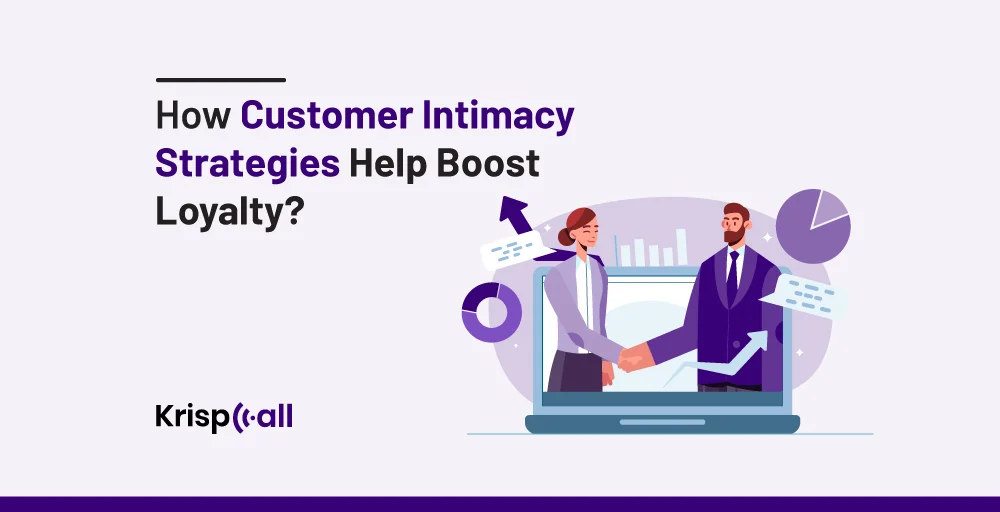Building a relationship with customers can be tough as business organizations experience competition 🏆 in many ways. Customers are very choosy and tend to shift to another brand if their expectations are not met. This makes it difficult for a firm to retain customers, and it most often leads to customers shifting to other firms 🏢.
To overcome this problem, businesses need to build a strong 💪 connection with customers. For a close relationship, they need to understand customer needs, gaps, and behavior. Designing the right things for customers helps to create a special bond with them. This forms a unique relationship that makes customers very loyal to their service providers📊, and that is customer intimacy.
In the blog post, we’ll discuss what customer intimacy is and also provide you with 9 proven customer intimacy strategies that can help boost loyalty and drive sustainable business growth🚀.
🔑 KEY HIGHLIGHTS
- Implementing a customer intimacy strategy allows businesses to maintain and establish strong relationships with customers to accurately identify their needs and requirements.
- To boost loyalty, businesses can employ 9 strategies: know your customer, prioritize their success, support their journey, empathize with them, analyze data for the right move, host valuable workshops like webinars, collect feedback, use CRM and reward loyalty.
- Implementing a customer intimacy approach can present challenges for businesses, such as being unable to adjust to customer needs and wants, focusing on short-term profits instead of relationships, and being unable to gain and keep customer loyalty.
- To measure customer intimacy, you need to calculate different factors like net promoter score (NPS), Customer Churn Rate, Customer Lifetime Value (CLV), Customer Satisfaction(CSAT) Score, Customer Effort Score(CES), Qualitative Feedback, and Employee Engagement.
What Is Customer Intimacy?
Customer intimacy is a strategic business model that aims to establish and maintain close relationships with buyers to accurately recognize their needs and requirements. It includes customer-focused dedication and information to comprehend consumer needs and develop enduring, adaptive, and close relationships with customers.
For example, New and powerful tools, like generative AI, are making it possible for companies to give their customers an excellent experience on a large scale. Businesses that offer products and services that match what their target customers want and need can greatly benefit from building strong, loyal relationships with them through customer intimacy.
The concept of customer intimacy is one of the 3 key elements of The Values Discipline Model, created by Michael Treacy and Fred Wiersema. It is a business framework that helps companies understand how to create value for their customers. The model consists of three key elements:
- Operational Excellence: This element focuses on providing products or services at the lowest possible cost, with high quality and efficiency. Companies that excel in operational excellence offer low prices and fast delivery to attract customers.
- Product Leadership: This element is about creating innovative, unique, and high-quality products that stand out from the competition. Companies that focus on product leadership constantly push the boundaries of technology and design.
- Customer Intimacy: Customer intimacy is about more than just providing good customer service. It’s about creating a deep understanding of each customer’s unique needs and preferences and using that knowledge to deliver personalized experiences that meet those needs.
9 Top Customer Intimacy Strategies To Boost Loyalty
Here is the list of several customer intimacy strategies to boost loyalty:
1. Understanding your customer
Knowing the customer’s needs and requirements is one of the crucial points for customer intimacy strategy. Once you understand their identity, requirements, and patterns of operation, it will be easy for your firm to accommodate their needs when selling products or services.
Also, it is useful to know your customers as it helps in building trust and can make the customers loyal. Loyalty and word of mouth are two of the biggest factors that customers can show when they feel appreciated by your company. It is also not limited to the exchange of goods and services for financial consideration but entails the development of mutually friendly relationships between the company and the consumer.
2. Prioritize Customer Success first
Customer success as a strategy has to involve developing approaches that enable customers to derive the most optimum value from the products or services offered. This can be done through orientation programs that help new clients use the product and client follow-ups to help tackle challenges the new clients face while using the product.
For instance, a software company like KrispCall prioritizes customer success by assigning a dedicated customer success manager to each new client. This manager provides personalized onboarding sessions, sets up regular check-ins, and offers tailored training to ensure the client gets the most out of the software. By putting customer success first, KrispCall has been able to build a loyal customer base that drives growth and referrals.
3. Support Your Customers’ Journey with Your Product
Knowing your customers’ behavior is helpful when it comes to defining the key points of interaction where you can improve the experience. This is the process of defining individuals involved in the decision-making process when choosing a company or product to buy.
Customer journey optimization and mapping make it easier to understand the different phases of customer experience and which ones require further enhancement. Understanding each stage helps to define the problems and ways to make the process even more valuable and enjoyable for the customer.
4. Get Your Team on the Customer’s Eye Level
To get a better perspective of the market and your target customers, your team must be able to think like the clients. This would need to be done with empathy, which may be taught in some respect but they do require experience and learning. Empathy training educates employees on adopting the emotions of a customer, thus achieving customer friendship.
This way, you will make sure that your team members are ready to address different customer-related scenarios with proper respect and sensitivity. Another one is customer feedback meetings, which allow customers to share their experiences and discuss what alterations should be made.
5. Data analysis for the right moves
Data analysis is a good technique that, when used, will assist businesses in taking correct actions based on the actual occurrence and tastes of the customers. Since the customers are the main recipients of the marketing messages, marketers need to obtain and analyze the data related to their activities to define patterns and trends.
Therefore, by using the insights from big data, you can increase your understanding of the customer’s requirements, improve customer lifecycle management, and effectively personalized marketing campaigns. Similarly, with the help of predictive analytics, one can also predict customer behaviors and trends in the future and, therefore, make an appropriate decision.
6. Value-driven customer Workshops/Webinars
When used in the right manner, workshops and webinars can be powerful tools that can be used to deliver value to the customers by sharing knowledge on the specific product and the market. This is also a perfect chance where the client gets to interact with the company on a higher level thus taking them closer to your company.
Such events are also useful for establishing direct communications between your customers and your team, or even other users, which in turn create a sense of belonging. In summary, workshops, and webinars are powerful communication tools that will help you forge stronger bonds with your customers and achieve your business goals.
7. Focus on Customer Feedback
Feedback is an important part of understanding customer service experience and identifying potential areas for development. Customer feedback can also be gathered by surveys, which help to periodically check clients’ views, and feedback forms, which allow clients to express their views regarding certain aspects of the company.
Using various modes of data collection, one is able to gather results that will be of help in developing a format that analyses such things as trends and patterns. This would help you to resolve clients’ issues, make necessary choices, and introduce improvements that help you to improve customer satisfaction.
8. Use CRM to Build and Maintain Relationships
Customer Relationship Management (CRM) systems can be used as a tool for tracking and maintaining customer relations and interactions right from the initial stage to the post-purchase stage of the customer journey.
A CRM system also has the capability of having a centralized database for customer information, making it convenient for such information to be collected and processed. Having access to customer data CRM simplifies and allows for specific interaction based on the needs of customers at any given time.
9. Recognize and Reward Loyal Customers
Rewarding loyalty is a special approach that is effective at maintaining the positive behaviors that are related to business and sales. One can use this by encouraging customers to make repeat purchases through the use of loyalty benches which reward the customer for repeated business.
Acknowledging the customers who have been loyal to the organization’s services through social media or even through newsletters also goes a long way. By recognizing and rewarding customer loyalty, businesses can create a sense of belonging and encourage customers to continue their loyalty. This can lead to positive word-of-mouth, online reviews, and ultimately, increased customer retention and acquisition.
Challenges Of Customer Intimacy
Building strong relationships with customers has many advantages, such as making them more loyal, increasing their value to the business, and setting the company apart from competitors. However, it also comes with some difficulties. One of the main challenges is keeping up with customers’ changing needs and wants, which are always shifting.
Another big problem is gaining and keeping customers’ trust. Nowadays, people are worried about sharing their personal information because of hacking and data leaks. Companies need to be honest about how they use customer data and always keep their promises to earn and keep customers’ trust.
Also, many businesses face strong competition, which can make them focus on making quick money instead of building strong relationships with customers. This can hurt their efforts to be close to customers. To overcome this, businesses need strong leaders, a willingness to wait for long-term results, and a focus on customers that everyone in the company shares.
Conclusion
To build loyalty, strength, and customer intimacy, businesses need a plan to really understand their customers. This means knowing what they need, like, do and then making products and services that fit them well. By doing this, businesses can keep customers happy and loyal and talk positively about the brand.
Customer intimacy goes beyond simple transactions, focusing on creating personalized and memorable experiences for each customer. By consistently putting your customers first and addressing their needs, you can build a loyal customer base that not only stays with your brand but also advocates for it. The journey towards customer intimacy is ongoing, but with the right strategies in place, you can achieve lasting success.
FAQ
Why is Customer Intimacy Important?
Customer intimacy is important because it is the foundation for building an emotionally connected and high-value customer base for sustainable growth. Deeply understanding the customer and their unique needs can foster business loyalty, generate revenue, and drive sustainable growth.
How to measure customer intimacy?
To measure customer intimacy, you require a multi-level approach. You need to calculate various key metrics such as Net promoter score(NPS), Customer Churn Rate, Customer Lifetime Value(CLV), Customer Satisfaction(CSAT) Score, Customer Effort Score(CES), Qualitative Feedback, and Employee Engagement.





